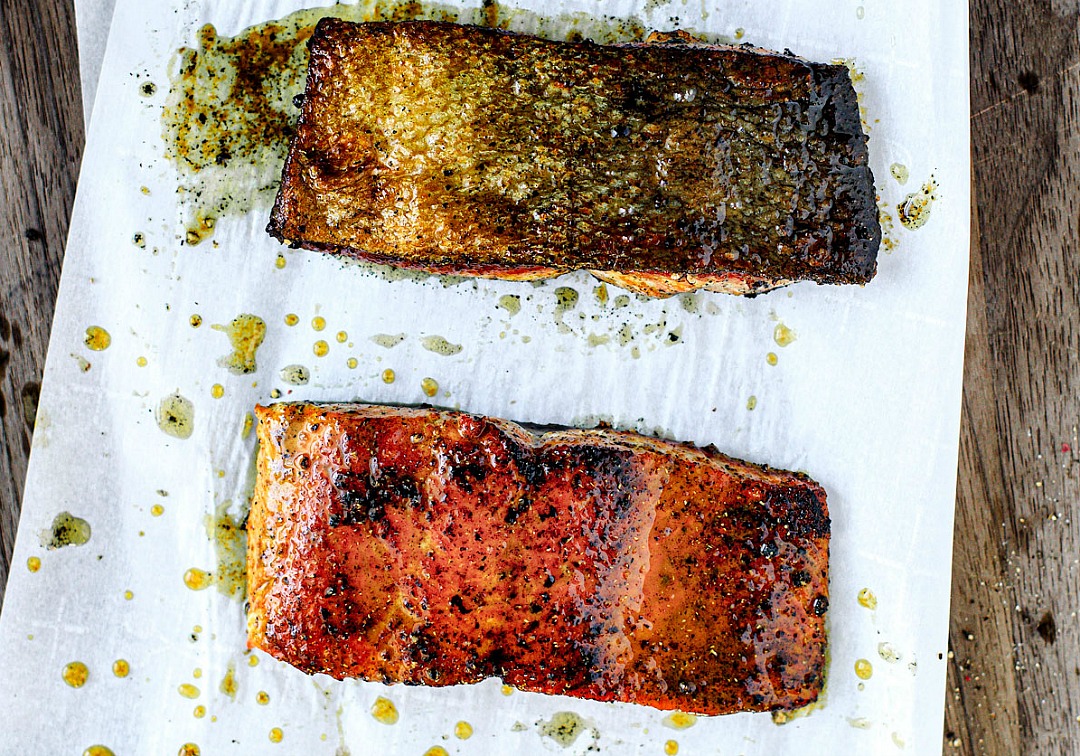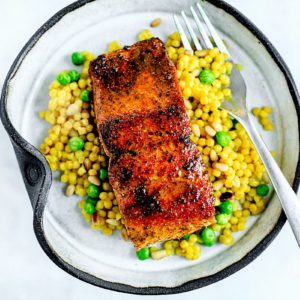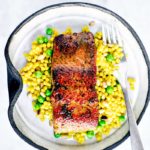This post contains affiliate links. Please see our disclosure policy.
Smothered in a lip-smacking maple curry butter, this pan-seared salmon is flaky, delicious, and complete with crispy skin!

I’ll happily eat salmon each and every way: roasted, grilled, sashimi-style, smoked… you name it. But there’s something a little extra about a pan-seared salmon with crispy skin. And when it’s slathered in a sweet and savory maple curry butter? Even better.
Aside from the awesome crunch factor, salmon skin offers up a great deal of nutrients. Salmon is known for being rich in Omega-3 fatty acids—but most of that is in the skin. Unfortunately, the skin usually gets cut off and tossed; people are afraid of it. Because if it isn’t cooked to a nice crisp, you get a bit of a chewy, slimy mouthful. Nobody wants that.
Table of Contents
How to choose your salmon.

Different types of salmon have different textures and flavors. King (Chinook) salmon is fatty and tender, while pink salmon is light in flavor with a lower fat content. (King and Faroe Island are my absolute favorite.) Whichever fillets you decide on, consider the following:
- Look for fillets that are firm and bright in color; you’re looking for bouncy flesh and shiny skin. A good trick is to press down on your fillet with your finger tip. Fresh fish will spring back up. If the fillet holds the form of your fingerprint, it’s not fresh.
- When it comes to cuts, center cuts are best shaped for an even cook; they’re also the most attractive fillets for serving.
- A six ounce fillet is the perfect portion for an individual.
Tips on cooking pan-seared salmon with crispy skin.

Cooking fish can be intimidating because it’s so easy to overcook. But once you get the hang of it, you’ll feel like a pro. Here are some things to remember when trying to perfect pan-seared salmon with a crispy skin:
- Remove the fish from the refrigerator about 15 minutes before cooking. Bringing fish closer to room temperature will help you get a more even cook.
- Blot the fillets with paper towels to get rid of extra moisture.
- Always place your fillets into a really hot pan to prevent the flesh from sticking to the pan.
- Place the salmon skin-side down and, as soon as it hits the pan, press down on it with a spatula. Pressing the fillet helps to keep the skin firm against the pan and prevents your fillet from curling upward from the high heat.
- Once you’re fillet hits the surface of the pan, leave it alone. Never push it around or lift it with a spatula before it’s properly cooked on that side, otherwise you’ll tear the flesh. You’ll know it’s cooked when you can see golden edges forming along the sides of the fillet. Only then should you carefully slide your spatula underneath the fillet and turn it over. If the fillet doesn’t release from the pan, give it another 30 seconds and try again. Once you flip it, you should see a nice crispy skin as a result.
- Once you’ve flipped your salmon, continue to cook it until you have an internal temperature of 140-145º F. If you don’t have a meat thermometer, cook the fish until it’s opaque and flakes easily with a fork. And then go buy a meat thermometer ;) (Seriously. They’re a game changer.)
How long do you cook salmon?

I swear by the 10 Minute Rule, or the “Canadian Cooking Method”. This works for all conventional methods including grilling, broiling, poaching, steaming, sautéing, microwaving, en papillotte, planking, and baking at around 400-450º F. Here’s how it’s done:
- Cook fish about 8-10 minutes per inch, turning it just over halfway through the cooking time. If your fish steak is 1-inch thick, cook it for 6 minutes on one side and 2-4 minutes once flipped, depending on the doneness you like. Typically, pieces less than 1/2 inch thick do not need to be turned over. When done, the fillet should easily flake with a fork and have an internal temperature of 140-145º F.
- For fish cooked in foil or in sauce, add 3-5 minutes to the total cooking time.
- *Use this rule as a general guideline since fillets often don’t have uniform thickness.
What should I serve with my pan-seared salmon with maple curry butter?
I like serving mine over a bed of pearled couscous tossed with peas and toasted pine nuts. These fillets would also be great with my Hot Honey Roasted Carrots, or a fluffy mound of basmati rice. Let me know what you serve them with in the comments below!
Here are some other salmon recipes I love.
- Grilled Salmon with Bruschetta Mix
- Cedar Plank Salmon with Fennel and Broccoli Rabe Salad
- Easy Grilled Salmon Kebabs with Homemade Chimichurri
- Pan-Seared Salmon with Apple Cranberry Sauce

Pan-Seared Salmon with Maple Curry Butter
Equipment
- Cast iron skillet or non-stick skillet
Ingredients
- 2 TBSP Olive oil or avocado oil
- 2 6 oz fillets of salmon
- Kosher salt and cracked black pepper, to taste
Maple Curry Butter.
- 3 TBSP butter
- 1 tsp curry powder
- 1/2 TBSP pure maple syrup
Instructions
Preparing the salmon.
- Remove the fillets from the fridge and, with a paper towel, pat the entire fillets dry — skin included. Sprinkle a little salt and pepper over the front and backs of the fillets and let them sit on the counter for about 15-20 minutes to come to room temperature. In the meantime you can prep your ingredients for the sauce.
Maple Curry Butter.
- Place 3 TBSP of butter into a small microwave safe dish and heat in the microwave until just melted. Once melted, add the curry powder and the maple syrup. Whisk with a fork to combine and set it aside.
Salmon.
- Add the oil to your skillet—enough to coat the bottom of the pan. Heat the skillet over high heat until the oil starts to smoke.
- Carefully place one salmon fillet into the hot pan, skin-side down. As soon as the fillet hits the pan, press down on it with a spatula for a few seconds until the fillet flattens out; bring the heat down to medium. Pressing the fillet keeps the skin firm against the pan and will give you crisp results without curling your fillet upward. Let your salmon cook until you can see a nice golden brown color on the edge of the skin (cooking time depends on fillet thickness; see notes). DO NOT touch, push, or try to budge your salmon while it's cooking; you'll tear the skin. Once you see the golden edges, smother a TBSP or two of the maple curry butter over the top of the salmon, then carefully slide your spatula underneath the fillet and turn it over. (If it doesn't release, give it another 30 seconds and try again.)
- Once you've flipped your salmon, continue to cook it for just a few more minutes until the fish is opaque and flakes easily with a fork. If you have a meat thermometer, remove the salmon once it's reached an internal temperature of 140-145º F.
- Carefully remove the fillet from the pan and set it on a plate; cover with tin foil so it stays warm. Repeat the same process for the other fillet. Once the fillets are done, plate, and spoon or brush the extra maple curry butter over each of them.






